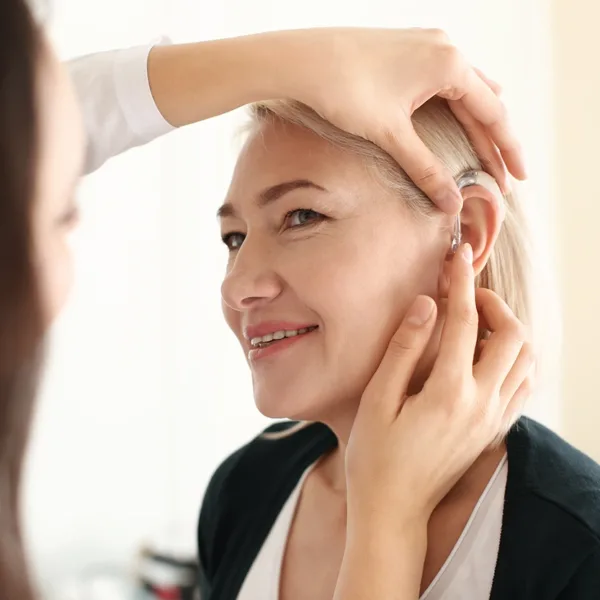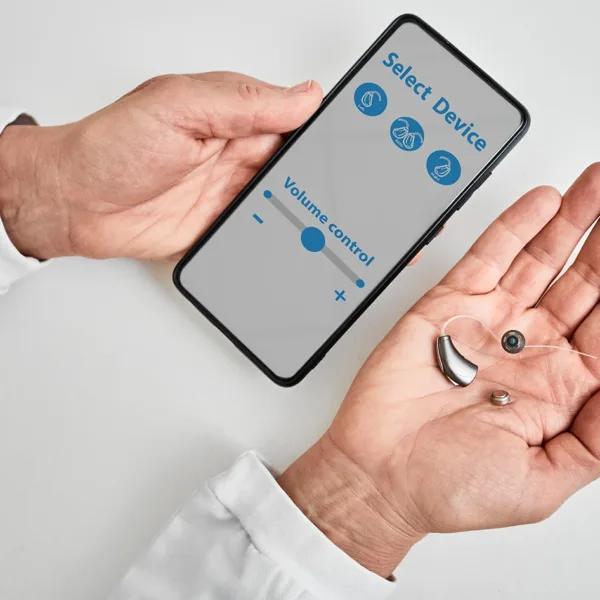
Have you ever found yourself straining to hear conversations, especially in noisy environments? If so, you’re not alone. The struggle to understand speech can be a frustrating part of hearing loss, but the good news is, the right hearing aids can help. This article explores how hearing aids improve speech clarity, highlighting the innovative technology used to enhance communication even in challenging environments.
How Hearing Loss Affects Speech Clarity
For many people with hearing loss, conversations can be a daily challenge to navigate. Certain words may be harder to hear than others, resulting in gaps in conversations, and specific environments may even make it impossible to discern speech entirely. In these all-too-common scenarios, several factors can contribute to the challenge of speech comprehension.
People with hearing loss often struggle to hear high-pitched sounds. This can make it tough to understand higher-pitched voices and even certain consonants like “s,” “t,” “p,” and “f,” leaving gaps in conversations. The other challenge is background noise. Things like traffic noise, chatter, or background music can easily drown out speech, making it difficult to pick out someone’s voice from all the surrounding sounds.
Fortunately, advancements in hearing aid technology offer solutions to these problems, providing improved speech clarity even in the most challenging listening environments.
How Hearing Aids Help with Speech Recognition
Modern prescription hearing aids are packed with features designed to address your specific needs. These advanced hearing aids come equipped with powerful processing technology and are programmed to benefit your unique hearing requirements. They can improve speech clarity while actively minimizing background noise, making conversations easier to follow in most environments.
Below, we explain the various technologies used in many prescription hearing aids to help enhance speech recognition and improve your hearing experience overall.
Digital Signal Processing (DSP)
At the core of all prescription hearing aids lies the Digital Signal Processor (DSP), a powerful chip that analyzes incoming sound waves. Unlike basic sound amplification devices, hearing aids with DSP technology can analyze incoming sound, and optimize it to best suit your specific hearing needs.
This allows for targeted amplification, making voices louder and clearer while minimizing unwanted sounds like background noise. They can also adjust the frequency response based on your specific hearing loss, ensuring you hear the full range of sounds critical for speech comprehension. Better yet, this entire process occurs in real time, adjusting sounds almost instantly.
Automatic Noise Reduction Technology
Building upon the foundation of clarity DSP technology provides, many hearing aids boast automatic noise reduction capabilities as well. Whether it’s the hum of traffic or ambient chitchat at dinner, these noises can mask speech, making it difficult to understand conversations.
Hearing aids with automatic noise reduction technology combat this using advanced algorithms to differentiate between speech and background noise. The distracting noise is then suppressed, while the speech frequencies are amplified.
This advanced technology also adjusts noise reduction levels automatically based on your listening environment. In a quiet room, less noise reduction is applied, while in a noisy restaurant, the system ramps up to prioritize speech.
Adaptive Directional Microphones
Many prescription hearing aids are also equipped with adaptive directional microphones. While less advanced hearing aid microphones (omnidirectional microphones) pick up sounds from all around you, adaptive microphones act like a spotlight for speech. They can focus on specific sounds from a precise direction and focus on the conversation you want to hear.
As the name suggests, adaptive directional microphones can also automatically adjust their focus. If someone speaks from the side, the microphone will shift its attention, ensuring clear speech no matter where the conversation flows. This constant adjustment, combined with background noise reduction, makes listening more natural, and conversations easier to understand, even in noisy places.
Personalized Programming
Hearing loss is unique for everyone, and no two people have the same needs. The specific frequencies you struggle with can vary depending on the type and severity of your hearing loss. To optimize speech recognition, prescription hearing aids can be programmed to your specific hearing loss profile.
During your comprehensive hearing evaluation, your specialist will be able to determine the precise sound frequencies you have difficulty hearing. They will then program your hearing aids to amplify these specific frequencies, resulting in a more natural listening experience and improved speech understanding.
Wireless Connectivity
Thanks to advances in wireless technology, many hearing aids now come with Bluetooth connectivity built in. This feature allows them to connect seamlessly with smartphones, tablets, televisions, and more. With Bluetooth hearing aids, you can stream phone calls, music, and even audio from your favorite shows straight to your hearing aids.
This improves the sound’s clarity and eliminates the challenge of competing background noise. Some hearing aids with Bluetooth connectivity can also be controlled remotely using smartphone apps. This allows you to adjust volume, switch between listening programs, and even personalize your listening experience for different environments.
Artificial Intelligence (AI)
Artificial intelligence (AI) is rapidly transforming the world of hearing aids. AI hearing aids use advanced algorithms to analyze the sounds happening around you. This allows them to constantly fine-tune your settings to suit your listening environment and optimize for speech clarity. These micro-adjustments happen automatically, requiring no effort on your part, empowering you to enjoy more effortless conversations again.
AI hearings don’t stop there though. These incredible devices can even identify familiar voices, automatically boosting their clarity. This, combined with cutting-edge noise reduction, creates a more natural listening experience where conversations come through crisp and clear.
Find the Best Hearing Aids for Speech Clarity
Thanks to modern technology, hearing aids are more powerful than ever. If you’re experiencing hearing loss and struggling with speech recognition, prescription hearing aids can make a world of difference.
At Audibel, we offer a wide range of advanced hearing aids featuring the latest technologies discussed above. Our experienced hearing care specialists will work with you to understand your specific needs and recommend the ideal hearing aids for optimal speech clarity and improved communication.
Schedule an appointment at a clinic near you to take the first step toward better hearing today.







Have a question or Comment?